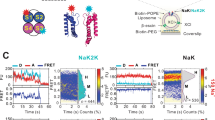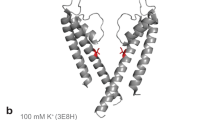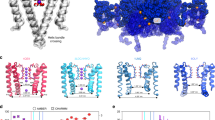Abstract
Modal-gating shifts represent an effective regulatory mechanism by which ion channels control the extent and time course of ionic fluxes. Under steady-state conditions, the K+ channel KcsA shows three distinct gating modes, high-Po, low-Po and a high-frequency flicker mode, each with about an order of magnitude difference in their mean open times. Here we show that in the absence of C-type inactivation, mutations at the pore-helix position Glu71 unmask a series of kinetically distinct modes of gating in a side chain–specific way. These gating modes mirror those seen in wild-type channels and suggest that specific interactions in the side chain network surrounding the selectivity filter, in concert with ion occupancy, alter the relative stability of pre-existing conformational states of the pore. The present results highlight the key role of the selectivity filter in regulating modal gating behavior in K+ channels.
This is a preview of subscription content, access via your institution
Access options
Subscribe to this journal
Receive 12 print issues and online access
$189.00 per year
only $15.75 per issue
Buy this article
- Purchase on Springer Link
- Instant access to full article PDF
Prices may be subject to local taxes which are calculated during checkout






Similar content being viewed by others
References
Hille, B. Ion Channels of Excitable Membranes (Sinauer Associates Inc., 2001).
Yellen, G. The moving parts of voltage-gated ion channels. Q. Rev. Biophys. 31, 239–295 (1998).
Doyle, D.A. et al. The structure of the potassium channel: molecular basis of K+ conduction and selectivity. Science 280, 69–77 (1998).
Kuo, A. et al. Crystal structure of the potassium channel KirBac1.1 in the closed state. Science 300, 1922–1926 (2003).
Zhou, Y., Morais-Cabral, J.H., Kaufman, A. & MacKinnon, R. Chemistry of ion coordination and hydration revealed by a K+ channel–Fab complex at 2.0 A resolution. Nature 414, 43–48 (2001).
Jiang, Y. et al. Crystal structure and mechanism of a calcium-gated potassium channel. Nature 417, 515–522 (2002).
Long, S.B., Campbell, E.B. & Mackinnon, R. Crystal structure of a mammalian voltage-dependent Shaker family K+ channel. Science 309, 897–903 (2005).
Long, S.B., Tao, X., Campbell, E.B. & MacKinnon, R. Atomic structure of a voltage-dependent K+ channel in a lipid membrane-like environment. Nature 450, 376–382 (2007).
Cuello, L.G., Jogini, V., Cortes, D.M. & Perozo, E. Crystal structure of open-inactivated KcsA and the mechanism of C-type inactivation in K+ channels. Nature 466, 203–208 (2010).
Schoppa, N.E. & Sigworth, F.J. Activation of shaker potassium channels. I. Characterization of voltage-dependent transitions. J. Gen. Physiol. 111, 271–294 (1998).
Cordero-Morales, J.F. et al. Molecular determinants of gating at the potassium-channel selectivity filter. Nat. Struct. Mol. Biol. 13, 311–318 (2006).
Chakrapani, S., Cordero-Morales, J.F. & Perozo, E. A quantitative description of KcsA gating II: single-channel currents. J. Gen. Physiol. 130, 479–496 (2007).
Zagotta, W.N., Hoshi, T. & Aldrich, R.W. Shaker potassium channel gating. III: Evaluation of kinetic models for activation. J. Gen. Physiol. 103, 321–362 (1994).
Schrempf, H. et al. A prokaryotic potassium ion channel with two predicted transmembrane segments from Streptomyces lividans. EMBO J. 14, 5170–5178 (1995).
Cuello, L.G., Romero, J.G., Cortes, D.M. & Perozo, E. pH-dependent gating in the Streptomyces lividans K+ channel. Biochemistry 37, 3229–3236 (1998).
Chapman, M.L. & VanDongen, A.M. K channel subconductance levels result from heteromeric pore conformations. J. Gen. Physiol. 126, 87–103 (2005).
Zheng, J. & Sigworth, F.J. Selectivity changes during activation of mutant Shaker potassium channels. J. Gen. Physiol. 110, 101–117 (1997).
Blunck, R., Cordero-Morales, J.F., Cuello, L.G., Perozo, E. & Bezanilla, F. Detection of the opening of the bundle crossing in KcsA with fluorescence lifetime spectroscopy reveals the existence of two gates for ion conduction. J. Gen. Physiol. 128, 569–581 (2006).
Chakrapani, S., Cordero-Morales, J.F. & Perozo, E. A quantitative description of KcsA gating I: macroscopic currents. J. Gen. Physiol. 130, 465–478 (2007).
Pusch, M., Bertorello, L. & Conti, F. Gating and flickery block differentially affected by rubidium in homomeric KCNQ1 and heteromeric KCNQ1/KCNE1 potassium channels. Biophys. J. 78, 211–226 (2000).
Demo, S.D. & Yellen, G. Ion effects on gating of the Ca2+-activated K+ channel correlate with occupancy of the pore. Biophys. J. 61, 639–648 (1992).
LeMasurier, M., Heginbotham, L. & Miller, C. KcsA: it's a potassium channel. J. Gen. Physiol. 118, 303–314 (2001).
Choe, H., Sackin, H. & Palmer, L.G. Gating properties of inward-rectifier potassium channels: effects of permeant ions. J. Membr. Biol. 184, 81–89 (2001).
Lu, T., Wu, L., Xiao, J. & Yang, J. Permeant ion-dependent changes in gating of Kir2.1 inward rectifier potassium channels. J. Gen. Physiol. 118, 509–522 (2001).
Lu, T. et al. Probing ion permeation and gating in a K+ channel with backbone mutations in the selectivity filter. Nat. Neurosci. 4, 239–246 (2001).
Zhou, M. & MacKinnon, R. A mutant KcsA K+ channel with altered conduction properties and selectivity filter ion distribution. J. Mol. Biol. 338, 839–846 (2004).
Haug, T., Olcese, R., Toro, L. & Stefani, E. Regulation of K+ flow by a ring of negative charges in the outer pore of BKCa channels. Part II: Neutralization of aspartate 292 reduces long channel openings and gating current slow component. J. Gen. Physiol. 124, 185–197 (2004).
Proks, P., Capener, C.E., Jones, P. & Ashcroft, F.M. Mutations within the P-loop of Kir6.2 modulate the intraburst kinetics of the ATP-sensitive potassium channel. J. Gen. Physiol. 118, 341–353 (2001).
Morais-Cabral, J.H., Zhou, Y. & MacKinnon, R. Energetic optimization of ion conduction rate by the K+ selectivity filter. Nature 414, 37–42 (2001).
Dreyer, I., Michard, E., Lacombe, B. & Thibaud, J.B. A plant Shaker-like K+ channel switches between two distinct gating modes resulting in either inward-rectifying or 'leak' current. FEBS Lett. 505, 233–239 (2001).
Singer-Lahat, D., Dascal, N. & Lotan, I. Modal behavior of the Kv1.1 channel conferred by the Kvβ1.1 subunit and its regulation by dephosphorylation of Kv1.1. Pflugers Arch. 439, 18–26 (1999).
Cooper, E. & Shrier, A. Inactivation of A currents and A channels on rat nodose neurons in culture. J. Gen. Physiol. 94, 881–910 (1989).
Armstrong, C.M. & Gilly, W.F. Fast and slow steps in the activation of sodium channels. J. Gen. Physiol. 74, 691–711 (1979).
Howe, J.R. & Ritchie, J.M. Multiple kinetic components of sodium channel inactivation in rabbit Schwann cells. J. Physiol. (Lond.) 455, 529–566 (1992).
Lenaeus, M.J., Vamvouka, M., Focia, P.J. & Gross, A. Structural basis of TEA blockade in a model potassium channel. Nat. Struct. Mol. Biol. 12, 454–459 (2005).
Bockenhauer, D., Zilberberg, N. & Goldstein, S.A. KCNK2: reversible conversion of a hippocampal potassium leak into a voltage-dependent channel. Nat. Neurosci. 4, 486–491 (2001).
Levin, G. et al. Phosphorylation of a K+ channel alpha subunit modulates the inactivation conferred by a beta subunit. Involvement of cytoskeleton. J. Biol. Chem. 271, 29321–29328 (1996).
Cordero-Morales, J.F. et al. Molecular driving forces determining potassium channel slow inactivation. Nat. Struct. Mol. Biol. 14, 1062–1069 (2007).
Capener, C.E., Proks, P., Ashcroft, F.M. & Sansom, M.S. Filter flexibility in a mammalian K channel: models and simulations of Kir6.2 mutants. Biophys. J. 84, 2345–2356 (2003).
Domene, C., Klein, M.L., Branduardi, D., Gervasio, F.L. & Parrinello, M. Conformational changes and gating at the selectivity filter of potassium channels. J. Am. Chem. Soc. 130, 9474–9480 (2008).
Bernèche, S. & Roux, B. Molecular dynamics of the KcsA K+ channel in a bilayer membrane. Biophys. J. 78, 2900–2917 (2000).
Shrivastava, I.H. & Sansom, M.S. Simulations of ion permeation through a potassium channel: molecular dynamics of KcsA in a phospholipid bilayer. Biophys. J. 78, 557–570 (2000).
Guidoni, L., Torre, V. & Carloni, P. Water and potassium dynamics inside the KcsA K+ channel. FEBS Lett. 477, 37–42 (2000).
Bernèche, S. & Roux, B. A gate in the selectivity filter of potassium channels. Structure 13, 591–600 (2005).
Nishida, M., Cadene, M., Chait, B.T. & MacKinnon, R. Crystal structure of a Kir3.1-prokaryotic Kir channel chimera. EMBO J. 26, 4005–4015 (2007).
Delcour, A.H., Lipscombe, D. & Tsien, R.W. Multiple modes of N-type calcium channel activity distinguished by differences in gating kinetics. J. Neurosci. 13, 181–194 (1993).
Luvisetto, S. et al. Modal gating of human CaV2.1 (P/Q-type) calcium channels: I. The slow and the fast gating modes and their modulation by beta subunits. J. Gen. Physiol. 124, 445–461 (2004).
Yue, D.T., Herzig, S. & Marban, E. Beta-adrenergic stimulation of calcium channels occurs by potentiation of high-activity gating modes. Proc. Natl. Acad. Sci. USA 87, 753–757 (1990).
McManus, O.B. & Magleby, K.L. Kinetic states and modes of single large-conductance calcium-activated potassium channels in cultured rat skeletal muscle. J. Physiol. (Lond.) 402, 79–120 (1988).
Rothberg, B.S., Bello, R.A., Song, L. & Magleby, K.L. High Ca2+ concentrations induce a low activity mode and reveal Ca2+-independent long shut intervals in BK channels from rat muscle. J. Physiol. (Lond.) 493, 673–689 (1996).
Auerbach, A. & Lingle, C.J. Heterogeneous kinetic properties of acetylcholine receptor channels in Xenopus myocytes. J. Physiol. (Lond.) 378, 119–140 (1986).
Milone, M. et al. Mode switching kinetics produced by a naturally occurring mutation in the cytoplasmic loop of the human acetylcholine receptor epsilon subunit. Neuron 20, 575–588 (1998).
Naranjo, D. & Brehm, P. Modal shifts in acetylcholine receptor channel gating confer subunit-dependent desensitization. Science 260, 1811–1814 (1993).
Popescu, G. & Auerbach, A. Modal gating of NMDA receptors and the shape of their synaptic response. Nat. Neurosci. 6, 476–483 (2003).
Patlak, J.B., Gration, K.A. & Usherwood, P.N. Single glutamate-activated channels in locust muscle. Nature 278, 643–645 (1979).
Huganir, R.L., Delcour, A.H., Greengard, P. & Hess, G.P. Phosphorylation of the nicotinic acetylcholine receptor regulates its rate of desensitization. Nature 321, 774–776 (1986).
Levy, D.I. & Deutsch, C. Recovery from C-type inactivation is modulated by extracellular potassium. Biophys. J. 70, 798–805 (1996).
Qin, F., Auerbach, A. & Sachs, F. Estimating single-channel kinetic parameters from idealized patch-clamp data containing missed events. Biophys. J. 70, 264–280 (1996).
Brooks, B.R. et al. CHARMM: A program for macromolecular energy, minimization and dynamics calculations. J. Comput. Chem. 4, 187–217 (1983).
Phillips, J.C. et al. Scalable molecular dynamics with NAMD. J. Comput. Chem. 26, 1781–1802 (2005).
Acknowledgements
We thank F. Bezanilla, L. Cuello, V. Vásquez and H. Raghuraman for insightful discussions; M. Wiener and M. Purdy for crystallographic data collection (for E71Q); the staff of the SER-CAT 22-ID and GM/CA-CAT 23-ID beamlines at the Advanced Photon Source, Argonne National Laboratory, for their invaluable assistance in data collection; R. MacKinnon (Rockefeller University) for providing the KcsA antibody hybridoma cell line; and the US National Center for Supercomputing Applications (NCSA) and the Laboratory Computing Resource Center (LCRC) at Argonne National Laboratory for computer time. This work was supported by US National Institutes of Health grants to E.P. (R01GM057846, U54GM087519) and B.R. (R01GM062342) and by an American Heart Association Postdoctoral Fellowship to S.C.
Author information
Authors and Affiliations
Contributions
S.C., J.F.C.-M. and E.P. designed the research. S.C. and J.F.C.-M. carried out electrophysiology measurements and kinetic analysis. D.M.C. made Fab preparations. J.F.C.-M. and D.M.C. crystallized the mutant proteins. V.J. determined and analyzed the structures. A.C.P. and B.R. did the computation analysis. S.C., J.F.C.-M. and E.P. analyzed the data and wrote the paper.
Corresponding author
Ethics declarations
Competing interests
The authors declare no competing financial interests.
Supplementary information
Supplementary Text and Figures
Supplementary Figures 1–6 (PDF 2955 kb)
Rights and permissions
About this article
Cite this article
Chakrapani, S., Cordero-Morales, J., Jogini, V. et al. On the structural basis of modal gating behavior in K+ channels. Nat Struct Mol Biol 18, 67–74 (2011). https://doi.org/10.1038/nsmb.1968
Received:
Accepted:
Published:
Issue Date:
DOI: https://doi.org/10.1038/nsmb.1968
This article is cited by
-
Conformational equilibrium shift underlies altered K+ channel gating as revealed by NMR
Nature Communications (2020)
-
Shifts in the selectivity filter dynamics cause modal gating in K+ channels
Nature Communications (2019)
-
Cryo-EM reveals ligand induced allostery underlying InsP3R channel gating
Cell Research (2018)
-
Unambiguous observation of blocked states reveals altered, blocker-induced, cardiac ryanodine receptor gating
Scientific Reports (2016)
-
NMR-based structural biology enhanced by dynamic nuclear polarization at high magnetic field
Journal of Biomolecular NMR (2014)



